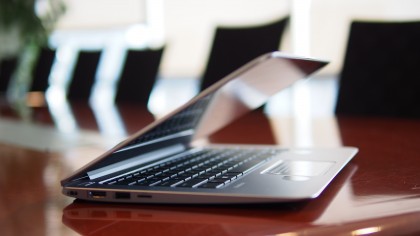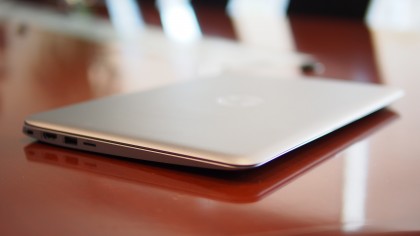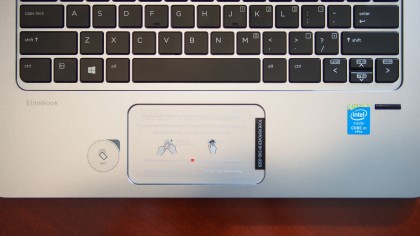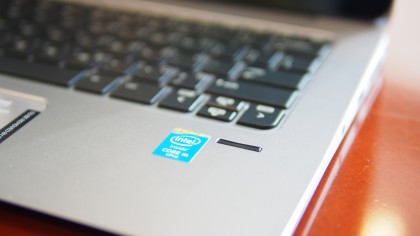Why you can trust TechRadar
Equipped with a power-efficient and fanless Intel Core M processor, there are trade-offs that users who choose the Folio must accept. You will trade in raw performance and a beefier battery for a slightly longer battery life and a slimmer design.
Here's how the unit sent to TechRadar for review was configured.
Spec sheet
- Processor: 1.2GHz dual-core Intel Core M-5Y71 with vPro (up to 2.9GHz with Intel Turbo Boost)
- Graphics: Intel HD Graphics 5300
- Memory: 8GB RAM (DDR3, 1,600Mhz)
- Storage: 256GB M.2 SSD
- Screen: 12.5-inch QHD UWVA touchscreen (2,560 x 1,440)
- Camera: 720p webcam
- Wireless: Bluetooth 4.0; dual-band 802.11ac (B/G/N), dual-band Wi-Fi
- Ports: HDMI, 2x USB 3.0 charging, microSD, docking connector, headphone/microphone combo
- Battery: Four-cell 36Whr
- OS: Windows 8.1 Professional 64-bit
- Enterprise security: TPM 1.2/2.0 (Infineon, soldered down); Fingerprint reader; Full Volume Encryption; Preboot Authentication (Password)
As configured, our review unit has a suggested retail price of $1,649 (£1,080, AU$2,165).
John Hagan, product manager of HP's business system, explained that HDMI is preferred over DisplayPort because it's found in more places – hotel room TVs, small conference room projectors, monitors – and that the optional docking station provides DisplayPort access.

When pressed about HP's choice to go with a microSD card reader over a full-sized one, Hagan confessed that the company ran out of space on the Folio and couldn't accommodate a regular SD card reader.
Performance
The Intel Core M and integrated graphics on the Folio will appeal to business users who spend most of their time inside PowerPoint presentations, spreadsheets, Word documents and the browser. As such, if you work with large Photoshop files or do heavy video production work you should look for a stronger Intel Core i3, i5 or i7 processor coupled with discrete graphics. If you're spending your time surfing the web, writing reports and creating presentations, the Core M CPU delivers enough power while stretching your battery life.
Benchmarks
- PCMark 8: Work: 2,268
- PCMark 8 Battery Life: 4 hours and 35 minutes (50% screen brightness)
- 3DMark: Fire Strike: 407; Cloud Gate: 1,551; Sky Diver: 1,526
- Cinebench: GPU: 15.44 fps; CPU: 139
As expected, both processor and graphics performance delivered by the Intel Core M chip is weaker than the performance of an Intel Core i5 system – like on the Acer Aspire R13 and Lenovo ThinkPad T450s. The Intel Core M is a mid-range processor, with performance that sits between the more energy efficient Intel Atom processor and the mainstream Intel Core i series.
The 15.44 GPU and 139 CPU scores generated using the Cinebench test is lower than both the 26.22 and 207 scores from the Aspire R13 and the 23.86 and 249 scores on the ThinkPad T450s, respectively.

In fact, the upgraded Core M-Y571 (compared to the Core M-Y510) on the Folio delivers similar Cinebench scores as the Dell Venue 11 Pro 7000 Series and the Microsoft Surface 3. The Surface 3 performed slightly better with a CPU score of 17.70 and a CPU score of 144.
However, processor performance using PCMark 8's work test is on par with Intel Core i5 systems. The Folio's score of 2,268 falls shy of the ThinkPad T450s's 2,896 and bests the Aspire R13's 2,190. The power efficient Core M processor on the Folio outlasted the ThinkPad's three hours and 45 minutes of battery life and the Aspire's three hours and fifteen minutes, but not by a significant margin.
Graphics performance was a different story, and the Folio scored significantly lower marks with 3DMark's Sky Diver, Fire Strike and Cloud Gate tests than the ThinkPad and the Aspire. The tests evaluate performance with heavy video rendering and gaming, and the results posted by the Folio are on par with other Core M systems, including the Venue 11 Pro 7000 Series, but weaker than systems with a Core i processor.
In my use, I got more than seven hours of battery life on the Folio using productivity software like Microsoft Office 2013, streaming short video clips on YouTube and working inside the browser using Google Apps. Battery life is on par with the Ultrabook category, but still falls short of MacBook's nine hours.
Keyboard and ForcePad
HP promotes the keyboard on the Folio as one of the best on the market, and I found those claims to be true. Evenly spaced keys, consistent key pressure and satisfying key travel make typing a joy on the Folio.
While the keys are evenly spaced, spacing between each key is smaller on the Folio than on the MacBook Pro. It's unclear why HP opted for closer key spacing as there is plenty of room to expand the keyboard. Because of the layout, typing feels cramped at first, but after a brief adjustment period, I was able to type accurately at full speed.

I noticed that the keys are also springy and responsive, but typing on the Folio's keyboard sounds more muted than on the MacBook Pro. HP placed the key cap extremely close to the underlying key dome mechanism to dampen key sound, something that's important if you're looking to type meeting notes in a quiet conference room.
The water resistant keyboard drains at the bottom in the event you spill water. This business-class feature ensures that you don't lose data or ruin your system if you spill coffee in the morning, an important consideration for road warriors working in cramped space. The Folio also comes with backlighting for use in dark environments.
HP uses Synaptic's pressure-sensitive ForcePad for the touchpad. While the branding sounds similar to the Force Touch touchpad on the Apple MacBook, there are a few notable differences. Both touchpads are buttonless, clickless and recognize gestures, but HP's implementation does not come with haptic response to give your fingers the illusion that you're clicking down with subtle vibration motors. Instead, if your volume is turned on, an audible click is played to simulate a button click.

I found the ForcePad to be usable, but without haptic feedback I wasn't always confident that a click was registered as I like to mute the volume on my machines when using them at work.
Enterprise users will appreciate the HP Sure Start technology, featuring a self-healing BIOS. HP claims that there is a second copy of the BIOS that's stored on the system. In the event of a malware attack on the BIOS, the system will boot safely into the second copy of the BIOS. Once that happens, the Folio will wipe the affected BIOS and copy the unaltered BIOS over for booting.
Display
The main complaint I have with the display is that it only opens up to about 135 degrees. This is fine when you're using the notebook on a desk, but ergonomics is compromised when using the Folio as a laptop.
Typing with the notebook in my lap, it seems that I am straining to look down on the Folio's display, rather than at the screen. It seems a bit shortsighted of HP to not include a 180-degree lay-flat hinge for better collaboration.

If you're using the display to watch movies, you'll be pleasantly surprised at how loud the speakers get. Even though the Folio doesn't have audio tuning from HP's Beats or Bang & Olufsen partnerships, sound output quality should be more than adequate for personal movie watching.
